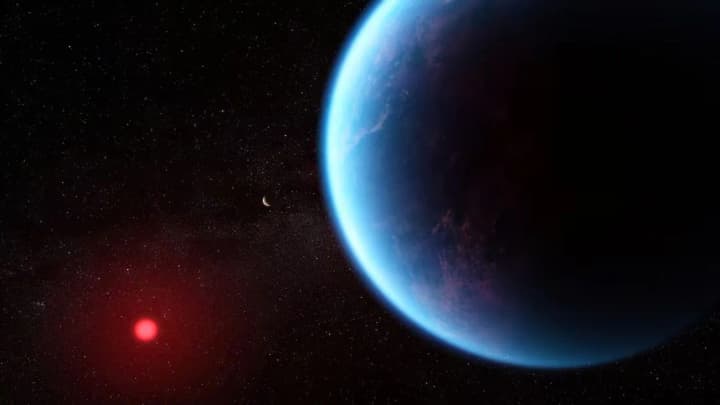Traces of life beyond the Solar System: scientists have discovered strange substances in the atmosphere of a giant planet
Kyiv • UNN
Dimethyl sulfide and dimethyldisulfide, which are produced by algae, have been found on the planet K2-18 b. This may indicate the presence of life, but further research is needed.

On the giant planet K2-18 b, located 124 light-years from Earth, scientists have discovered chemicals that are produced by algae on Earth. This has led scientists to argue about the possible existence of life on this planet.
This is reported by UNN with reference to The Guardian.
Details
Observations from the James Webb Space Telescope of a planet called K2-18 b helped to detect chemical signatures of two compounds that are known to be produced only by life on Earth. The detection of the chemicals dimethyl sulfide (DMS) and dimethyldisulfide (DMDS) is not 100% proof of alien biological activity, but may bring us closer to answering the question of whether there is life on other planets.
"This is the strongest evidence to date of biological activity outside the Solar System. We are very careful. We must ask ourselves whether the signal is real and what it means. This could be a turning point, when suddenly we can answer the fundamental question of whether we are alone in the Universe," said Professor Nikku Madhusudhan, an astrophysicist at the University of Cambridge, who led the observations.
Other scientists are more skeptical, as questions remain. In particular, whether the general conditions on K2-18 b are conducive to life and whether DMS and DMDS, which are mainly produced by marine phytoplankton on Earth, can be considered as signals of biological activity.
Observations
K2-18 b is located in the constellation Leo. This planet is almost nine times more massive than Earth and 2.6 times larger. It revolves in the life zone of its star, a cold red dwarf, less than half the size of the Sun. In 2019, the Hubble Space Telescope detected water vapor in the atmosphere of K2-18 b, and then scientists declared it the "most habitable world" outside the Solar System.
During further observations by Madhusudhan's team in 2023, it was discovered that the appearance of steam was triggered by methane, but K2-18 b still fell under the definition of a habitable planet, as it is covered by a huge, deep ocean.
However, scientists continue to argue about the possibility of biological activity there.
Planets outside our Solar System are too far away to be reached by robotic spacecraft. But scientists can estimate their size, density, and temperature, and explore the chemical composition by tracking an exoplanet as it passes in front of its host star and measuring the starlight that has passed through its atmosphere.
In the latest observations, it was noticed that the wavelengths that absorb DMS and DMDS suddenly decrease when K2-18 b wanders in front of the red dwarf. This may indicate a sufficient amount of these substances there.
The signal was strong and clear. If we can detect these molecules on habitable planets, this is the first time we can do this as a species... it's amazing that it's possible
The findings, published in The Astrophysical Journal Letters, suggest that the concentration of DMS and DMDS is thousands of times higher than on Earth. There remains 0.3% that the sudden decrease in waves was accidental, which does not meet the gold standard for discoveries in physics.
There may be processes that we don't know about that produce these molecules. But I don't think there is any known process that could explain this without biology
Disputes among scientists
The difficulty in identifying other potential processes that would indicate the existence of life there lies in the fact that the conditions on K2-18 b remain controversial. While the Cambridge team prefers an oceanic scenario, others say the data suggests a gas planet or a planet with oceans made of magma rather than water.
There is also the question of whether DMS could have been brought to the planet by comets. This would require an intensity of bombardment that seems incredible. It is also suggested that the substance could have been produced in hydrothermal springs, volcanoes or thunderstorms through exotic chemical processes.
Life is one option, but it is one of many. We will have to strictly rule out all other options before claiming life
My skepticism about any claims relating to evidence of life is constantly returning to 11, not because I don't think there is other life there, but because I feel that for such a profound and important discovery, the burden of proof must be very, very high
ESA showed the Great Barrier Reef from space13.04.25, 03:25 • 6462 views